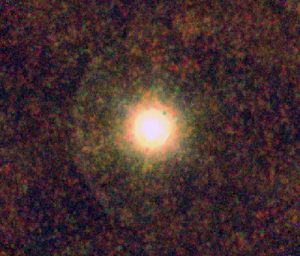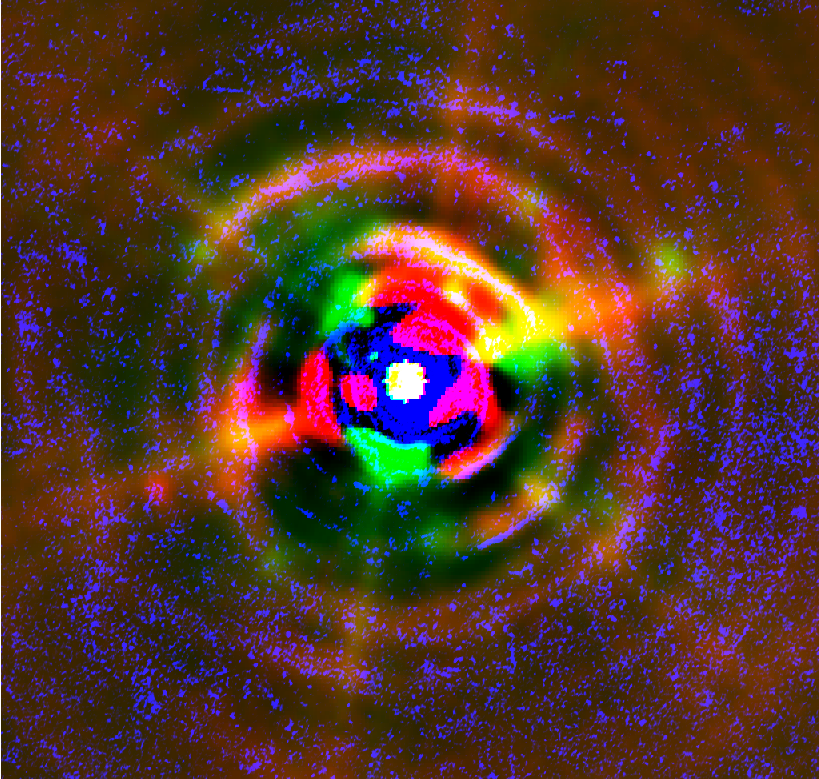| Basic Information | |
| What is this? | Dust rings seen around the star CW Leonis |
| Where is it in the sky? | In the constellation of Leo the Lion |
| How big is it? | The star is thousands of times the size of our Sun, but the dust rings lie trillions of kilometres away |
| How far away is it? | Around 500 light years away |
| What do the colours represent? | Red and green are the dust detected by Herschel, while blue is the scattered optical light seen by the Very Large Telescope. The light from the central star itself has been removed. |
Downloads
See this object in:
The star CW Leonis is showing signs of old age, much as our own Sun will do in around five billion years. It has entered the giant phase of its life, now thousands of times larger than the Sun, and is throwing off its outer layers. This forms shells of dust around the star, which had been seen before in optical light. New images from the PACS instrument on board Herschel have shown that they stretch much further than have been seen before. To see the dust rings, the light emitted by the central star itself had to be removed from the image. The set of six spikes is due to diffraction of the intense light from the star around the support structure of the telescope.

The star has an inert core of carbon and oxygen, surrounded by layers of helium and hydrogen in which nuclear fusion is taking place. Most of the star is a large envelope of hydrogen, which is expanding as the star cools. Dust is condensing in the outer layes, and as the star pulsates a stellar wind of gas and dust is ejected from its surface. Our own Sun has a stellar wind, but much, much weaker. The gas and dust around CW Leonis form shells, which are expanding outwards at around 14.5 km/s (30,000 miles per hour). The detected shells contain more dust than the smoother cloud that surrounds the star.
The distance the shells have travelled can be used to determine when they were expelled. The brighter inner ones are up to 4000 years old, but the outer ones seen by Herschel are up to 17,000 years old. These shells are now trillions of km from the star and have cooled to around -248 Celsius, just 25 degrees above absolute zero, meaning that they can only be observed in the far-infrared light that Herschel’s instruments measure. The star has been pulsating and ejecting dust for hundreds of thousands of years, but the older shells would have been destroyed when they met the interstellar gas and dust that surrounds the star. The strong stellar wind causes a bow shock as the star ploughs thorugh the interstellar medium.

The dating of these shells indicates how the star has behaved in its relatively recent past, and can give clues as to the origin of the dust shells. They have been ejected at intervals of between 500 and 1700 years, but are irregularly spaced, implying that the ejection speed of the dust may have varied over time. They are also incomplete, forming arcs rather than entire rings, which implies that there may have been variations in the temperature of the gas surrounding the star.
At a distance of around 500 light years, CW Leonis is one of the closest evolved stars that can be studied, and is called an “Asymptotic Giant Branch” star. In 2010 the same team discovered that water is present in the star’s envelope, one possible cause of which was the “clumpy” nature of the star’s surroundings.
More information is available on the ESA Science and Technology website.

